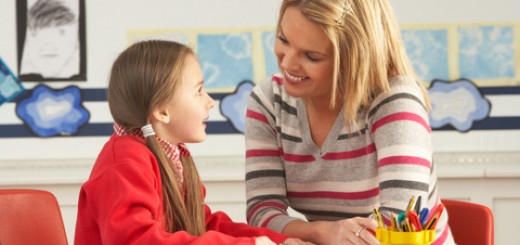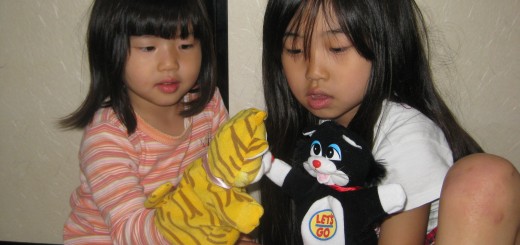Teaching Young Children English Through Song and Story Time
What can we do to help young mothers who want their toddlers and young children to learn English? Many international mothers are concerned that their English is not good enough to read to their children; but they would still like their children to hear stories in English.
A song and story time offers a great opportunity for both mothers and children to learn and practice English! It’s much more appropriate for toddlers than a regular English class, and it’s fun for both the children and their mothers. Singing simple children’s songs that repeat words and sounds is an excellent way for international toddlers to start learning English. At first, the children will just listen and watch; but as you repeat the same song over and over, they will quickly become familiar with the language. Eventually, they will start to sing along, naturally.
To help keep young children focused, also incorporate the element of surprise into your song and story time. One easy way to do that is to use a puppet that pops out of a box or other container. Using the same puppet in each song and story time helps the children think of the puppet as their friend. They look forward to seeing their friend each week and want to talk with the puppet friend.
For story time, use stories that are short and repetitive. When possible, incorporate gestures and actions into a story. Even if the children cannot say the words yet, they will do the gestures and actions, and will begin to associate them with the words. Be sure to alternate stories with the songs to keep the children engaged.
It’s best to begin your song and story time with a play period of 15-20 minutes. During this time, the children can play with color and alphabet puzzles, blocks and other age-appropriate toys that feature English words. This playtime allows the children to become comfortable playing near other toddlers. Have the mothers speak to you, and each other, in English as their children play. By doing this, you create an environment that helps the toddlers begin to develop receptive English vocabulary and listening skills.
Key Activities for Song and Story time
1. Start your song and story time with common children’s finger play songs, such as Where is Thumbkin?, The Itsy Bitsy Spider and Twinkle, Twinkle Little Star.
2. Follow these songs with a story that includes a lot of repetition. If possible, use a storybook that has peek-a-boo windows that you can slowly open. This builds anticipation and excitement for the toddlers, and they stay quite focused. I usually use the Brown Bear, Brown Bear story (Brown bear, brown, bear. What do you see? I see a (yellow duck) looking at me.) It repeats the phrase ‘What do you see?’ on each two-page spread. The children love this and after several weeks of hearing the story, they begin to say the lines as you read. (This supports teaching colors in Let’s Begin Unit 2, Let’s Learn and Let’s Learn More)
3. Now bring in the element of surprise! Children, especially toddlers, love surprises. If it’s a regular section of your lesson, they eagerly anticipate what is coming. I use a raccoon puppet that is housed in a garbage can. Before I reveal the puppet, I peek into the can and close it. Then I say something like this:
“Someone is waiting to see you! Do you remember who she is?”
(Now open the can.)
“It’s Ruby! She’s happy to see all of you!”
“Ruby, say hi to the boys and girls.”
(Ruby waves and says ‘hi’ to the boys and girls.)
“Boys and girls, can you say ‘Hi’ to Ruby?”
(The children wave and some say ‘hi’).
4. Ruby, the raccoon puppet, helps the children sing the Alphabet Song (A,B,C,D,E,F,G,etc) (Let’s Begin Unit 1 Let’s Learn to Read) and then reveals the letter of the week.


5. Show realia and picture cards of objects and animals that begin with that letter.
If the letter is ‘T’, show and identify pictures of the following items:
a teddy bear
a train (make the sound of a train whistle)
a tiger (roar like a tiger)
a triangle (make a triangle with your hands)
Do a gesture or make a sound with each word. Have the children do it with you and say the word.
(Practice ‘What is it? from Let’s Begin Unit 1 Let’s Learn More)
Use a song and/or an activity that features the letter of the week. For the letter T:
*Show the children how to turn around as you say ‘turn around’.
*Repeat ‘turn around and have the children do it with you.
Do this several times.
*Now, do the same with ‘touch the ground’
(Let’s Begin Unit 7 Let’s Learn)
Then sing Teddy Bear, Teddy Bear
Read another short story, like Trains.
Finish up the song and story time with other songs like:
Head, Shoulders, Knees and Toes (Let’s Begin Unit 7 Let’s Learn More) and
I’m a Little Teapot (Let’s Begin Unit 6 Let’s Learn to Read).
Now is the Time to Say Goodbye is a great song for closing your Song and Story Time.
I’ve found that hosting a song and story time is a good way to introduce English songs and stories to young children. It not only helps the toddlers develop English skills; but it also shows the young mothers what they can do at home to help their very young children learn English. I hope you’ll try a song and story time sometime!
Do you take your children to story time? Do you have story time at your school or library? Please tell us about it in our comments sections.













Recent Comments